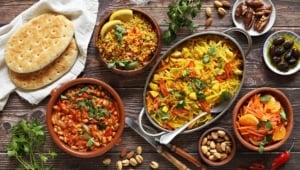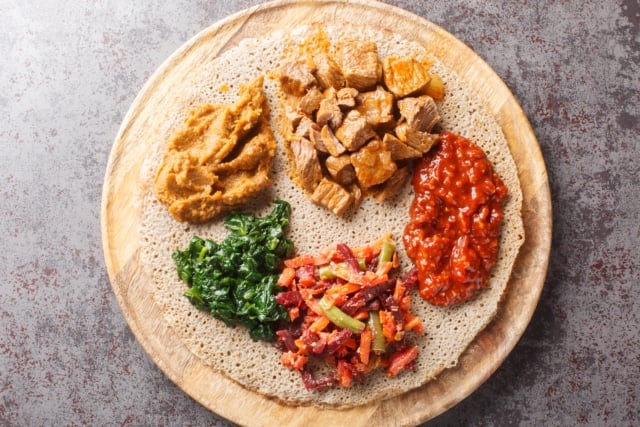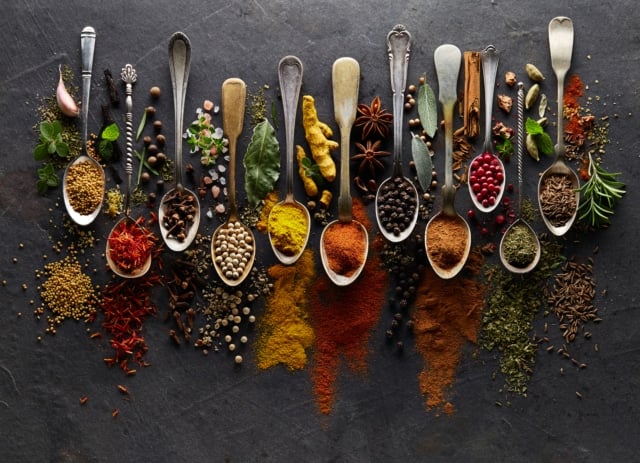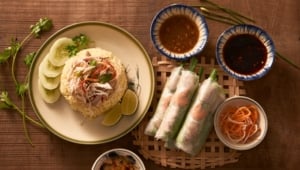Ethiopian Food: 5 Popular Dishes + 3 Reasons Why It’s Healthy

Delve into the deeply ingrained, flavor-packed world of Ethiopian cuisine, where each dish is a tour de force of taste and tradition. Stick with us, and you’ll soon be whipping up authentic Ethiopian dishes with the verve of a seasoned chef.
Nothing speaks authentic Ethiopian like the street food, it’s a crash course in traditional food but enjoyed on the lanes and bylanes of towns and cities.
Get ready to dive into a symphony of flavors, typically served on a communal platter, teaching you a thing or two about the culture of sharing.
Traditional Ethiopian Cuisine- More than Doro Wot and Kitfo

Traditional Ethiopian Cuisine- More than Doro Wot and Kitfo
Okay, first off, Ethiopian cuisine isn’t just about devouring raw beef on Wednesdays and Fridays or relishing Doro Wot – a spicy chicken stew, or Kitfo – minced, typically served raw meat.
No, it is a magnificent mélange of flavors, textures, and aromas, resonating with the rich Ethiopian culture. It’s like being on a thrilling culinary trip to Ethiopia without leaving your kitchen.
Most Popular Street Food in Ethiopia

Most Popular Street Food in Ethiopia
One of the most loved street foods is “tibs” – chunks of meat sautéed and stir-fried to perfection, hotter than your high school sweetheart.
Be it beef, lamb, or chicken, the trick is in the marination, and when eaten right off the skillet with bits of injera, you’ll find yourself smack in the center of a flavor carnival.
Speaking of injera, this sourdough-risen flatbread with a unique, slightly spongy texture, is the main event in every meal. Tore into shreds, dunked into hot stews, or served alongside glistening meats, there’s no escape from the delicious domination of injera.
Now, remember it isn’t Ethiopian until it hits your heat palette. Meet “Dulet” – minced onions, green chili peppers, and lean meat (usually beef), a triple-threat combo cooked in butter till it gets your taste buds thumping with excitement.
Enjoy it with Ethiopian honey wine or authentic Ethiopian beer, and you’ll be transported to the vibrant streets of Addis Ababa.
Ethiopian Food in the World

Ethiopian Food in the World
When we talk about Ethiopian food peeping its delicious head around the globe, we’re talking about more than just folks abroad getting a taste of this remarkable cuisine.
We’re talking about how the world has started venturing into the authentic Ethiopian food realm and embracing it wholeheartedly.
In major cities around the globe, you can now hear kitchen stories of the berbere spice blend brought in, teff flour sorted, and cooking techniques adapted to rustle up some marvelous Ethiopian fares.
From roadside stalls in Bangkok to high-end restaurants in New York, people across the world, regardless of their cultural background, are putting their adventurous palate to the test.
Consequently, the influence that authentic Ethiopian food has on global cuisine is as dynamic as ever.
Further, it’s not just about the dishes, but also about their accompanying culture of communal eating that seems to make its way to other cultures as well.
Remember, Ethiopian food has a pretty sociable vibe to it, what with the tradition of feeding each other, known as 'gursha'.
However, Ethiopian food’s global popularity doesn’t stop at merely captivating taste buds; it’s heating things up in the culinary world as well.
Chefs and food critics alike are drawn to a cornucopia of Ethiopian ingredients like injera, a kind of fermented flatbread; berbere, a spice blend; and 'shiro', a thick gravy.
How Healthy Ethiopian Food Is

How Healthy Ethiopian Food Is
You know the drill – eat plenty of fruits, veggies, whole grains, and lean protein. But did you ever guess that Ethiopian cuisine delights may just line up with these nutritious needs? It’s a culinary paradise that doesn’t mind considering your abs, as it delivers the goods to your taste buds.
High-Fiber Grains

High-Fiber Grains
The Ethiopian meal scene boasts tons of high-fiber grains and nutrient-packed vegetables. One popular example is teff, the smallest grain in the world, don’t you know, but calms your health worries with huge benefits.
This grain’s packed with an unimaginable amount of protein, fiber, and calcium. If beans are more your thing, Ethiopian cuisine could easily become your new best friend.
Chickpeas (garbanzo beans) and lentils make their star appearance in numerous dishes, packing a bunch of protein and fiber onto your plate.
Fermentation For Your Health

Fermentation For Your Health
Now imagine having your meal served on a pancake-like bread called injera, which will not only solicit some nod of approval from your taste buds but also from your gut.
Sourdough starter and fermentation means it’s good for your gut health. And get this, it is traditionally made from the power grain – teff – a nutshell nutrient package.
Healthy Herbs and Spices

Healthy Herbs and Spices
To complete the health section, Ethiopian cuisine often errs on the generous side in the use of herbs and spices.
Turmeric, garlic, ginger, basil – all these commonly used ingredients possess their own health benefits that range from anti-inflammatory properties to promoting digestion.
This doesn’t just add an unexpected spiciness to your food; it’s also a fantastic method of sneaking in those health benefits. So next time you eat out, let those worries take a backseat and dive into some Ethiopian delight.
Famous Ethiopian Dishes You Have to Try

Famous Ethiopian Dishes You Have to Try
They say good food is like music for the stomach. You start tapping your toes, snapping your fingers, and swaying, all because of a tasty plate set before you.
Now, if you’ve never tried Ethiopian food, let us tell you, you’re missing out on quite the symphony. So, here are five famous Ethiopian dishes to try that’ll have you dancing in your seat.
Injera

Injera
Now Injera, it’s like the Rolling Stones of Ethiopian food. This stuff’s everywhere. It’s a type of sourdough flatbread, kind of like a big, spongy pancake.
They use it as an edible utensil to scoop up all kinds of stews and salads. And get this: it’s made from teff flour, which is super nutritious. A little bit sour, pleasantly spongy, full of iron – it’s a taste adventure.
Doro Wat

Doro Wat
Then you gotta try Doro Wat. Imagine, a chicken stew so rich and flavor-packed that it would make a Thanksgiving turkey blush.
It’s intensely spicy, thanks to Ethiopian berbere spice, and it’s slow-cooked to perfection. Pair it with some Injera, and it’s like a jazz duo creating unforgettable melodies right there on your plate.
Kitfo

Kitfo
Next on the setlist is Kitfo – a dish not for the faint of heart, but for the brave of palate. You’re looking at finely chopped raw beef, seasoned with mitmita – a chili powder with a kick like a mule – and niter kibbeh, a spiced clarified butter.
It’s a little like steak tartare’s rocking Ethiopian cousin. Some folks like it lightly cooked, but the traditional way is raw.
Tibs

Tibs
Let’s move on to Tibs. If steaks played in a blues band, the lead singer would be Tibs.
It’s a dish of bite-sized meat (lamb, beef, or goat), pan-fried or sautéed with a bunch of spices, herbs, and sometimes veggies. It’s served hot—a sizzling performance that leaves the audience cheering for more.
Shiro

Shiro
Last but not least, all great Ethiopian meals end on a harmonious note with Shiro. It’s a smooth, comforting stew made from powdered chickpeas or lentils, often mixed with minced onions, garlic, and a generous dash of berbere spice.
The slow, simmering rhythm of Shiro might be the treasured encore you never expected.
In the end, Ethiopian cuisine is a vibrant, colorful, and highly rhythmic genre of food. It incorporates beautiful harmonies of spices, layers of textures, and a never-ending spectrum of flavors.
Soups & Salads

Soups & Salads
Now, if we’re talking Ethiopian cuisine, we simply can’t overlook the soups and salads. Take note of the popular Shiro, a soup with a base of chickpea and broad bean flour, simmered into a thin but flavorful onion- and tomato-based concoction.
It’s usually spiced up with an unmistakable Ethiopian blend of spices called berbere. If you’ve never tasted it, consider this your gustatory wake-up call. Smooth, spicy, with just the right hit of umami – it’s a soup that sings.
Moving on to the salads, you sure gotta try Timatim Salata. Built on a base of diced ripe tomatoes, the salad also incorporates green peppers, red onions, and a hit of fresh lemon juice.
This salad sends a cool and refreshingly zesty punch straight to your palate, balancing out those fiery Ethiopian dishes just right.
Beyond these staples, Azifa is another vivid addition. This green lentil salad is seasoned with jalapeno, lime, and mustard, creating a fusion of flavors that throws a straight-up party in your mouth.
Healthy and bursting with flavors, these soups and salads lend a hearty deliciousness to any Ethiopian meal.
Starters, Sandwiches, and Sides

Starters, Sandwiches, and Sides
Shifting gears to Ethiopian starters, let’s kick things off with Sambusa. Think of these pastries as the Ethiopian take on samosas, filled with lentils, onions, and a blend of spices. They’re practically the ideal snack – crispy pastry, hearty filling, with a bit of heat to keep things interesting.
But in Ethiopia, sandwiches are a whole other ball game. Consider the popular Kategna – it’s pure flavor fireworks. Picture this: a griddled injera bread slathered up with chili-infused kibe butter, then toasted till it’s crispy.
After one bite, you’ll understand why this sandwich is an all-time street food favorite.
Hearty and homely, Gomen is a dish featuring collard greens simmered in a blend of spices, onions, and garlic, sometimes with a touch of minced meat.
Then there’s Fosolia, a green bean, and carrot medley sautéed in onions and garlic, light but certainly no slouch in the taste department. These are the kind of side dishes that would make anyone want to eat their greens – no nagging necessary.
Mains

Mains
Let’s dive right into the heart of Ethiopian cuisine. Picture if you will, a generous spread of hearty stews, all layered on a platter of injera bread – it’s a feast.
One of the more popular main dishes is Wats, a type of spicy, thick stew made with chicken, beef, lamb, or a mixture of these. It gets its kick from the berbere spice blend, a fiery combination with a punch on your palate.
Then we’ve got Kitfo, a raw or partially cooked minced meat delicacy. It might feel like a culinary bungee jump for the faint-hearted, but there’s a calming yin to this yang- it’s usually served with a side of mitmita, a slightly pungent spice made from African bird’s eye chili peppers.
Now, if you prefer a veggie route, then your heart might lean towards Aterkik Aletcha, a gentle yellow split pea stew – just as filling, but without the meaty hustle.
Another staple of Ethiopian meals, is Doro Wat. This chicken stew is filled with flavored onions, ginger, and the good old berbere spice blend.
It’s a celebration of your senses. When served piping hot on a bed of injera flatbread, it tastes like comforting love on a plate.
Bread, Pastries, Dessert

Bread, Pastries, Dessert
Moving over to bread, pastries, and desserts, injera bread tops the charts. A fermented bread with a distinct sourdough flavor, injera often serves as both your fork and your edible plate, soaking up the juices of the good stuff right up.
Then there’s the breakfast dish, Chechebsa, also known as Kita Fir-Fir. It’s a savory mosaic of shredded injera flatbread, berbere spice blend, onions, and a spiced clarified butter called niter kibbeh. Those mornings when this fills your kitchen.
Let’s not forget about Ethiopian donuts, or 'Dabo Kolo'. These small, crispy, pieces of heaven are mildly sweet and make for a nice midday snack.
They’re kind of like an extra special bag of potato chips; once you start, there’s no stopping. Equally addictive, but slightly more traditional, is Genfo, a barley porridge served with clarified butter and spicy chili on top.
And finally, don’t you dare skip dessert in Ethiopia. You might find yourself wrapping things up with a plate of traditional honey bread – Yemarina Yewotet Dabo.
Kissed with a blend of spices and blessed with a hearty pouring of honey, it’s like a heavenly cloud of sweetness in your mouth. It’s the perfect grand finale for a flavourful Ethiopian feast.
Secret Recipe Tips

Secret Recipe Tips
Ethiopian cooking is an art that requires a touch of magic, or should we say, a handful of secret ingredients and techniques. Let us share a few of them with you.
Berbere Spice

Berbere Spice
First secret – Berbere spice. This fiery red blend is akin to the heart of Ethiopian cooking: bold, full of character, and not shy to turn up the heat.
Consisting of chili peppers, garlic, ginger, and various other herbs, it’s a secret weapon in the kitchen that’ll transform any dish from ordinary to extraordinary.
Injera Bread

Injera Bread
Tip number two – injera bread. This spongey delight isn’t just any other bread, it’s your cutlery, your plate, your taste-enhancer. If you’re aiming for authentic Ethiopian cooking, mastering injera is a must. It’s made with teff flour, leaves a slightly sour taste, and is an integral part of every meal.
Niter Kibbeh

Niter Kibbeh
The third tip revolves around the cooking oil, Niter Kibbeh. This isn’t your regular cooking oil, it’s an Ethiopian butter flavored with an array of spices.
It leaves a delightful aroma and adds a unique taste to your cooking. Coupled with berbere spice, it creates a flavor playground that irresistibly invites the taste buds.
Awaze Sauce

Awaze Sauce
Secret tip number four is Awaze sauce. Think of it as the salsa of Ethiopia; tangy, spicy, and the perfect dipping companion. It’s often made with berbere spice, honey wine, and other local ingredients.
It’s All about Patience

It’s All about Patience
Finally, the fifth tip is all about patience. Traditional Ethiopian meals are often slow-cooked to allow the flavors to develop and mature. So, if it takes a bit longer than you originally planned, sit back, relax, and give the stew its simmering time.
Beverages

Beverages
If there’s one thing you should remember about Ethiopian beverages it would be their range; from coffee to honey wine, there’s something for everyone.
First up, we’ve got coffee, or as Ethiopians call it, 'buna'. Ethiopia is the birthplace of coffee and its traditional coffee ceremony is a spectacle you won’t want to miss.
Involving jebena (a clay coffee pot), fresh coffee beans, and a lot of charisma, it’ll turn your simple mug of coffee into an experience.
But let’s not forget about the honey wine, Tej, which is an Ethiopian specialty. It’s sweet, strong, and packs a punch in the flavor department. Ideally enjoyed relaxed, and savored, it’s a drink that reflects the calm character of Ethiopia in a glass.
Ingredients

Ingredients
What makes Ethiopian food so good, you ask? Well, it’s all in the ingredients. We’ve got a unique blend of flavors packing a big-time punch. Now, I know what you’re thinking.
It’s all about the spices, right? And okay, you’re not wrong but, there’s more to Ethiopian cuisine than just the seasonings.
Firstly, remember that Ethiopian and Eritrean food isn’t just about packing a punch. After that spice blast, you’ll find there’s a depth of flavor that holds it all together.
Special ingredients like teff flour, used in their one-of-a-kind staple bread injera, and kibbeh, a spiced and clarified butter, give Ethiopian food its signature taste. But wait till we get to the herbs and spices.
Herbs and Spices

Herbs and Spices
Ethiopian cuisine lives and dies on its herbs and spices. It’s like a real-life magic show, you know? A combination of berbere, garlic, ginger, basil, cardamom, and fenugreek creates a symphony of flavors that’ll have your taste buds dancing.
Remember, it’s not just about the heat; it’s about the harmony of flavors. Mastering this spice game is an art form. It’s what makes Ethiopia’s culinary culture so distinct and downright tantalizing.
Next time you find yourself in an Ethiopian restaurant, don’t be shy to request these spices and turn up the flavor game.
Ethiopian Food Culture

Ethiopian Food Culture
If you ask us, Ethiopian food culture should be compared to a well-conducted orchestra. The way food is served in these Ethiopian restaurants, on a large metal tray with spicy stews carefully ladled atop a bed of spongy injera, it’s nothing short of a performance.
The meals are highly communal with diverse vegan options for vegetarian folks, showing that Ethiopian cooking truly caters to everyone.
So, whether you’re a "meat-and-potatoes" kind of guy or a "leaf-and-lentil" type, you’ll find something to enjoy. Spiced just right, packed with vegetarian dishes, and bound to bring people together, Ethiopian food adds a zing to your everyday eating habits.
Eating Habits

Eating Habits
To truly understand Ethiopian culinary culture, one has got to take a look at the eating habits. You see, Ethiopians have a way of making mealtime a real event.
It’s not just "grab-and-go", you know? Eating is highly communal. Everybody gathers around the metal tray, tearing off pieces of injera and dipping them into shared stews and salads.
It’s a real communal affair, encouraging people to slow down, enjoy the food, and cherish the company.
Fun Fact
Ethiopians eat primarily with their right hand, using the injera bread as a utensil to scoop up the stews and other goodies. No need for forks or spoons, just tear, scoop, and enjoy the burst of flavors.
It’s a whole different experience. Trust me, it’s not just the food, but the way it’s eaten that makes Ethiopian cuisine so unique.
Meal Structure

Meal Structure
Ethiopian cuisine provides gourmet-style meal experiences catered to fit into varying diets. Now, pay attention to this, if you crave a meal that is free from animal products, just plan your visit on a Wednesday or Friday – that’s the traditional fasting day for Orthodox Christians in Ethiopia.
It’s a special day when an assortment of meat-free dishes, known as bayenetu, are generously served in restaurants.
The bayenetu brings a vibrant variety to the table. Dishes like gomen, a mix of collard green jazzed up with spices, or aterkik alitcha, a luscious yellow pea stew simmer up along with atkilt wat; an interesting hodgepodge of cabbage, carrots, and potatoes swathed in a rich sauce.
Fun Fact
Do you know the one major dish that whispers the soul of Ethiopia in every bite? It’s the chicken stew – a luscious, spicy assembly of flavors that awaken your senses.
Etiquette

Etiquette
Food is a cultural ambassador, and Ethiopian food is no different. The etiquette here is as unique as their food. Traditionally, partaking in a meal is a social occasion where food is eaten by hand; yep, you read it right, no forks or spoons. And don’t picture chaos, it’s actually a pretty cool, organized thing.
Food is served on a large, spongy pancake-like bread, injera, which doubles up as an edible spoon. Here’s the drill – tear off a piece of injera, wrap it around a dollop of vegetarian stew or, if you’re game, cubes of raw beef or lamb, and pop it gently into your mouth.
They call this shekla tibs. Did you just make a face? Well, eating raw beef or lamb is a centuries-old tradition, dating back to the 16th century.
And they’ve got subtleties nailed down right too. In the northern region, most dishes are heavily spiced with bold flavors that tingle your palate.
Recipes are skillfully seasoned with garlic and ginger, berbere and niter kibbeh (spiced butter), and chile powder for that kick.
If your taste preferences don’t call for a daring encounter with raw meat, do try their delectable breakfast dish, enkulal firfir, hard-boiled eggs mashed with fried bread, tomato paste, and finely chopped Ethiopian spices.
- French Food. Popular Dishes and Secret Tips.
- Lebanese Food. Ingredients, Dishes and Tips.
- Georgian Food.Popular Dishes and Ingredients.
- Turkish Food. Dishes, Tips and Facts.
- Korean Street Food. Popular Dishes and Recipes.
- Danish Food. Exciting Facts and Popular Dishes.





